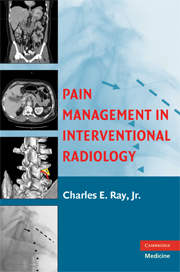Book contents
- Frontmatter
- Contents
- Contributors
- Preface
- Acknowledgments
- 1 Pain Management in Interventional Radiology: An Introduction
- 2 Clinical Evaluation of Low-Back Pain
- PART I LOCOREGIONAL PAIN CONTROL
- PART II SYSTEMIC PAIN CONTROL
- 16 Sedation and Analgesia Medications
- 17 Guidelines for Sedation Administered by Nonanesthesiologists
- 18 Pediatric Sedation for Radiological Imaging Studies and Interventions
- 19 Nontraditional Pain Management in Interventional Radiology
- 20 Postprocedural Pain Control
- Index
- References
19 - Nontraditional Pain Management in Interventional Radiology
from PART II - SYSTEMIC PAIN CONTROL
Published online by Cambridge University Press: 04 September 2009
- Frontmatter
- Contents
- Contributors
- Preface
- Acknowledgments
- 1 Pain Management in Interventional Radiology: An Introduction
- 2 Clinical Evaluation of Low-Back Pain
- PART I LOCOREGIONAL PAIN CONTROL
- PART II SYSTEMIC PAIN CONTROL
- 16 Sedation and Analgesia Medications
- 17 Guidelines for Sedation Administered by Nonanesthesiologists
- 18 Pediatric Sedation for Radiological Imaging Studies and Interventions
- 19 Nontraditional Pain Management in Interventional Radiology
- 20 Postprocedural Pain Control
- Index
- References
Summary
INTRODUCTION
Appropriate pain management (or lack thereof) is gaining increasing attention. The California Board of Registration in Medicine now requires CME in pain management. Court cases address the “right to pain relief.” A recent trend in judicial standard setting with regard to pain management is expressed in the opinion of Nowatske vs. Osterloh, Wisc 1996 (1): “Should customary medical practice fail to keep pace with developments and advances in medical science, adherence to custom might constitute a failure to exercise ordinary care.” Another judgment went as far to declare that “it is entirely possible that what is the usual or customary procedure might itself be negligence” (1). Although this legal interpretation has been applied predominantly to end-of-life pain management, one can see how juries sympathetic to any kind of medical suffering may react to ensure that what is known to reduce pain be used judiciously. There is a well-known place for analgesics, narcotics, sedatives, and anesthetics in interventional radiology (2,3). However increasing number of reports support an evidence-based use of nonpharmacological adjuncts for invasive procedures, and an increasing number of patients request such services. This chapter is intended to provide an overview of such methods, with special emphasis in procedural pain and distress management as they relate to interventional radiology.
RATIONALE FOR USE OF NONPHARMACOLOGICAL ADJUNCTS
Mild and moderate pharmacological sedation during and after interventional radiological procedures is widely practiced and well established but can have limited effectiveness and serious side effects.
- Type
- Chapter
- Information
- Pain Management in Interventional Radiology , pp. 280 - 295Publisher: Cambridge University PressPrint publication year: 2008



